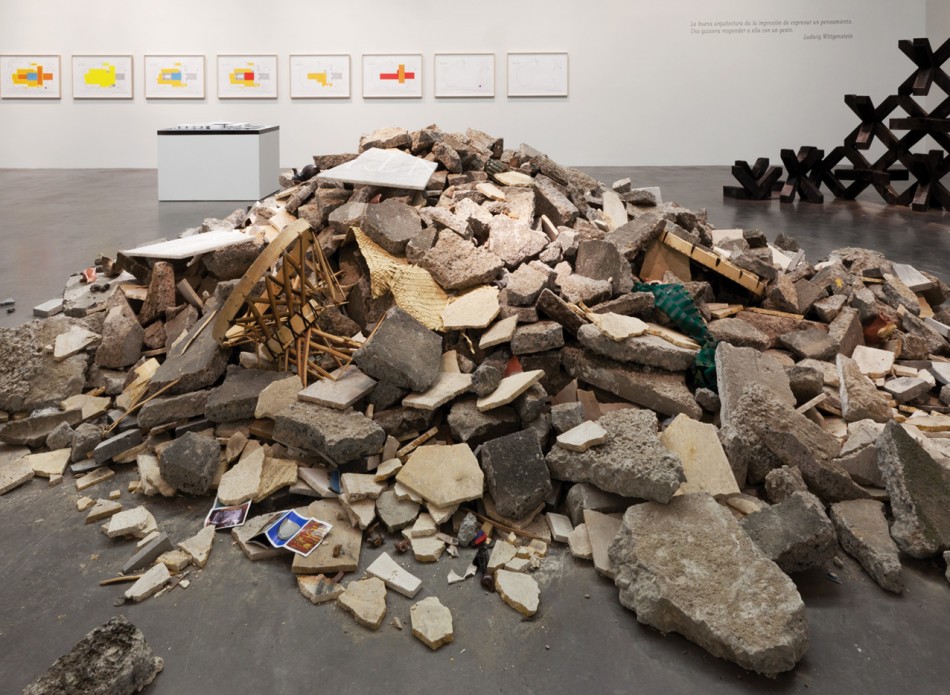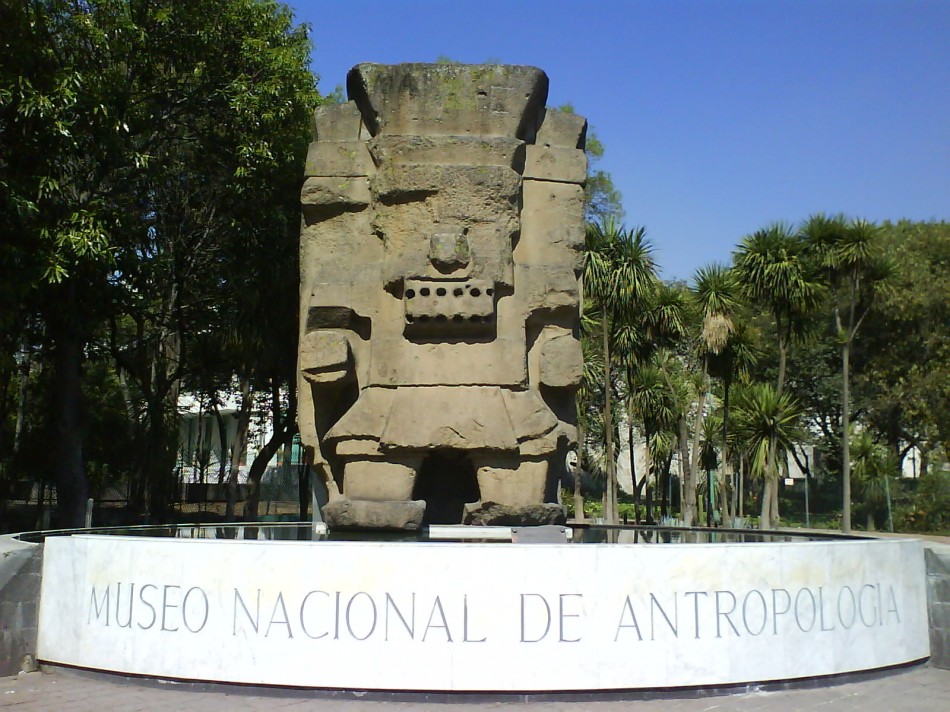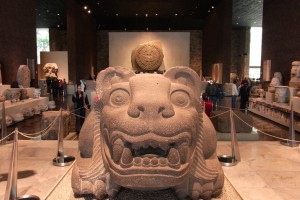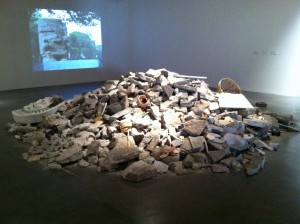
The Total Destruction of the National Museum of Anthropology: Eduardo Abaroa
In his recent installation at Kurimanzutto Gallery in Mexico City, Eduardo Abaroa imagines that the only response to the Mexican government’s failure to improve the lot of its indigenous peoples in the past half-century is to raze one of the regime’s most significant symbols, the Museo Nacional de Antropología.
Although it may at first seem naïve to make the artifacts and curators of a national archaeology and ethnology museum pay for the sins of politicians, the gesture strikes home when we consider how closely the institution was allied with the leadership of the Partido Revolucionario Institucional (PRI), or Institutional Revolutionary Party, which ruled Mexico for more than 70 years, until 2000, and which looks to have a better than fair chance of returning to power in the presidential elections this fall.

Coatlinchan monument, outside the Museo Nacional de Antropología, Mexico City
But why propose destroying a museum, therefore?
Although Mexico has had a national museum since the mid-1820s, none of its previous incarnations was planned as an ideological vehicle as carefully as the present structure, inaugurated in 1964. As designed by Pedro Ramírez Vásquez, a giant of mid-20th-century Mexican modernism, with input from many of the nation’s leading intellectuals and artists, the museum models archaeological stratigraphy, with ancient objects displayed in ground-floor galleries, and upstairs the material culture of the native peoples who live (or lived until recently) in the same geographic regions. So ancient Maya stelas are downstairs, while upstairs visitors can view dioramas of modern Maya homes peopled by mannequins and furnished with contemporary material culture. However, as in Edward Curtis’s photographs of Native Americans a century ago, clocks and radios (not to mention Ipads), and other obvious tokens that these people exist in time are banished from these scenes.
In the graven words of Alfredo López Mateos, Mexico’s president from 1958-1964, cut into stone in the museum’s grand foyer, the institution was intended to honor Mexico’s indigenous peoples, whose characteristics largely define Mexican nationalism, at least as it was constructed in the wake of the Revolution of 1910 and through the 20th-century.

Aztec or Mexica Room, Museo Nacional de Antropología, Mexico City
Soon after the museum opened, critics noted its ideological function, in reifying and siting the modern Mexican state’s origins in Pre-Columbian time. In his “Critique of the Pyramid,” (1970), Octavio Paz deconstructed an obvious feature of the museum’s physical space: the Aztec or Mexica archaeological display has no display of daughter cultures on the upper story. The double-height display showcases the Aztec Calendar Stone and other famous monolithic sculptures. The none-too-subtle implication is that modern Mexicans, especially the rulers of the PRI, are the heirs of Moctezuma and his empire.

Rubble of the Museo Nacional, and Coatlinchan monument video, Kurimanzutto Gallery, Mexico City
Like Paz, Abaroa’s stated intent was to deconstruct the museum, but not with a “heap of language,” to borrow Robert Smithson’s phrase. Abaroa instead imagines a project combining the “explosive” rhetoric of the Russian anarchist Mikhail Bakunin with an act of institutional critique. Long before the revolutions that would transform Russia and Mexico in the early 20th- century, Bakunin wrote that conflicts in the industrialized nations of Europe would take explosive, even volcanic form.
As Abaroa noted in the wall text at the exhibition’s entrance, the avant-garde—from Dada to Fluxus to punk—adopted the destruction of old orders as central organizing principles. One is reminded of Magritte’s On the Threshold of Liberty (1930), where a cannon threatens to blow away art history. He presents a combination of plans for how to demolish the museum; adaptive reuse of its more valuable components, such as aluminum; and a single-channel video that culminates with the detonation of a huge monolith located near the museum’s entrance. A large pile of the museum’s rubble, itself like an archaeological site, or better like the messy leavings of grave robbers, is at the exhibition center, as if a transmigration of Chris Burden’s “exposure of the foundations of the museum” to the foundations of creation itself.
Robert Smithson’s ghost haunts Abaroa’s installation, from the exercises in cartography to the large pile of rubble. I couldn’t help but think of Smithson’s non-sites, or his maps of Atlantis, Gondwanaland, and Lemuria. But this was no non-site. Nor was the rubble the result of entropy. Just the opposite.
Abaroa’s project is an exercise in iconoclasm, the destruction of an “idol” or collection thereof, so closely associated with Mexican nationalism that the gesture reminds one of the annihilation of the Twin Towers on 9/11, or the Bamiyan buddhas, just six months prior in March 2001.The rubble in the gallery contained the smashed fragments of Pre-Columbian sculptures and ceramics, as well as ethnographica, like Huichol Indian costume elements and drums, and the detritus of tourism. Abaroa’s attitude toward Mexico’s cultural heritage evoke’s Ai Weiwei’s Dropping a Han Dynasty Urn (1995).
What did Abaroa plan for the Aztec Calendar Stone, the pre-eminent symbol of both Pre-Columbian and modern Mexico? It was represented in the rubble only by postcards and images from guidebooks. Abaroa addressed the fate of another colossal sculpture, the Coatlinchan Tlaloc, in a 10-minute video.
The plans for the museum destruction called for the demolition of the building with pneumatic hammers, and clearing with heavy machinery. The last plan showed that the Coatlinchan monument would be disposed of by explosives, shown as the culmination of the video. That monument’s journey from the mountains outside Mexico City was the focus of great interest in 1964. At 168 tons, it was moved to Mexico City on a special trailer with dozens of tires, all televised in the pre-Twitter age, in a gesture that has just been replicated or at least echoed by the glacial progress of Michel Heizer’s Levitated Mass, 105 miles from Riverside, CA, through Los Angeles to LACMA.
Like Heizer’s rock, Abaroa imagines that the future for Mexican archaeology, culture and nationalism can be born from the rubble created by explosive interventions. One wonders if Mexico’s native population and the memory of its long gone Pre-Columbian peoples is better served by his museological and curatorial vision than that he seeks to obliterate.
